 Alex A. Aimetti PhD
Alex A. Aimetti PhD
Sr. Director, Medical Education and Scientific Support InVivo Therapeutics Corporation
Title: Translation of Biomaterial-based Therapies for the Treatment of Spinal Cord Injury: The Neuro-Spinal Scaffold™ and Bioengineered Neural Trails
Abstract: InVivo Therapeutics is focused on developing biomaterial-based therapies for the treatment of acute and chronic spinal cord injury (SCI). A porous, PLGA-based scaffold (Neuro-Spinal Scaffold™) is currently under clinical investigation for acute injuries and has been shown pre-clinically to promote tissue healing and facilitate remyelination and neural regeneration within the spinal cord. In addition, an injectable biomaterial cell-carrier is under development with the aim to replace lost cells and create neuronal relays in individuals with chronic injuries. This talk will focus on the development and clinical translation of biomaterial therapies as novel SCI treatments.
 Jason Burdick PhD
Jason Burdick PhD
Professor, Department of Bioengineering, University of Pennsylvania
Title: Injectable Shear-Thinning Hydrogels for Biomedical Applications
Abstract: Hydrogels represent a class of biomaterials that have great promise for the repair of tissues, particularly due to our ability to engineer their biophysical and biochemical properties. Hydrogels can provide instructive signals through material properties alone (e.g., mechanics, degradation, structure) or through the delivery of therapeutics that can influence tissue morphogenesis and repair. Here, I will give examples of the design of hydrogels based on hyaluronic acid (HA) for use as injectable therapeutics or towards 3D bioprinting applications. Towards cardiac repair, my laboratory is interested in designing materials that can influence the left ventricular remodeling process that occurs after myocardial infarction. To permit percutaneous delivery of hydrogels (e.g., via catheters), we have developed a class of shear-thinning and self-assembling hydrogels that can be used for the delivery of mechanical signals, as well as cells and therapeutics (e.g., protease inhibitors). These iterations on material design are teaching us what important signals are needed in these hydrogels towards the next generation of translatable therapeutics for cardiac repair. Beyond injectability, these hydrogels are also useful for bioprinting in the area of additive manufacturing. Our approach involves the printing of a shear-thinning and self-healing hydrogel ink into another support hydrogel in 3D space. This approach allows for the printing of cells, multiple inks into the support gel, and pockets of materials. Additionally, open and perfusable structures (e.g., channels) can be fabricated with secondary photocrosslinking of the support hydrogel and washing of the ink.
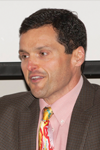 Michael Drues PhD
Michael Drues PhD
Consultant - Vascular Sciences
Title: Communication with FDA: What do we Say and How do we Say it?
Abstract: Effective communication with FDA is critical in successfully bringing any therapeutic product to market. However, communication includes much more than the written regulatory submission. Effective communication in all its forms must be concise, carefully considered, and reviewed to achieve the desired outcome. Communicating with the agency is not something to be taken lightly. The discussion will be focused on the FDA, but the same logic applies to dealing with Health Canada or the EU or any of the other regulators that medical device companies have to deal with.
 Jennifer H. Elisseeff PhD
Jennifer H. Elisseeff PhD
Jules Stein Professor, Wilmer Eye Institute and Biomedical Engineering, Translational Tissue Engineering Center, Johns Hopkins University
Title: Discovery of Regenerative Biomaterials Through Bench to Bedside Translation
Abstract: Humans have struggled for eons to replace tissues lost due to trauma, disease or congenital abnormalities, going back to the Ancient Egyptians where broken bones, dental implants, and even artificial toes were found in tombs. The field of tissue engineering, now frequently termed regenerative medicine, emerged in the late 1980’s to create biological tissue replacements. From there arose the concept of designing biomaterial scaffolds to actively engage with surrounding cells and to support tissue morphogenesis. Biomaterial scaffold research further exploded with the discovery of stem cells that required multiple biological signals to induce proliferation and differentiation. Today, biomaterials can be engineered with exquisite control and can present an array of biophysical cues in the form of peptides, sugars, and other biopolymers with varying mechanical and structural paradigms depending on the need. However, to efficiently translate regenerative medicine approaches to the clinic and observe biomaterial scaffold responses in people, we focused on the body’s innate capacity for repair that could be leveraged without the added complication of complex biological elements such as growth factors or stem cells. Clinical experience in translating biomaterials in orthopedics and plastic surgery led back to the lab and more systematic analysis of structure-function relationships and ultimately the discovery of the role of adaptive immune system in biomaterials response and biomaterials-directed regenerative immunology.
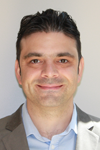 Murat Guvendiren PhD
Murat Guvendiren PhD
Assistant Professor
Otto H. York Department of Chemical Biological and Pharmaceutical Engineering, New Jersey Institute of Technology
Title: Designing Biomaterial Inks for 3D Printing of Tissue Engineering Scaffolds and Medical Devices
Abstract: 3D printing is emerging as a revolutionary method with a promise to revolutionize the medicine as we know it. One of the bottlenecks is the limited variety of 3D printable biomaterials with tunable properties. This presentation will overview currently available of 3D printable biomaterials, and summarize recent results on work done at the New Jersey Center for Biomaterials on designing novel ink formulations.
 Justin Hanes PhD
Justin Hanes PhD
Lewis J. Ort Professor of Ophthalmology, Biomedical Engineering, Chemical & Biomolecular Engineering, Environmental Health Sciences, Neurosurgery, and Oncology, Johns Hopkins University
Title: Drug and Nucleic Acid Delivery to the Brain
Abstract: Nanoparticle-based drug and nucleic acid therapies hold promise to improve treatments for a variety of brain disorders, including brain tumors and neurodegenerative diseases. However, it is difficult to achieve widespread drug and gene delivery in the brain due to the blood brain barrier and the nanoporous and highly adhesive extracellular matrix that minimizes distribution of nanoparticles once they reach the brain parenchyma. We recently demonstrated that sub-114 nm nanoparticles rapidly penetrated healthy brain tissue and brain tumor tissue, but only if they possessed an extremely high surface coverage of hydrophilic and neutrally charged polyethylene glycol (PEG). We used this knowledge to create drug and nucleic acid loaded nanoparticle formulations that more effectively spread within the brain parenchyma following local injection or infusion (“brain penetrating nanoparticles” or “BPN”). We showed that paclitaxel loaded BPN were more effective in treating rats with brain tumors than similar nanoparticles that do not penetrate as efficiently. Also, unlike DNA nanoparticles with standard PEG coatings, DNA nanoparticles with dense PEG coatings were highly stable in cerebrospinal fluid and rapidly diffused in freshly excised healthy and tumor rodent brain tissues ex vivo. Consistent with ex vivo transport behavior, these “DNA BPN” rapidly penetrated within the brain following administration by convection enhanced delivery, leading to markedly improved distribution and overall level of transgene expression compared to DNA nanoparticles with standard PEG coating densities. With our collaborators, led by Dr. Richard Price at the University of Virginia and Jung Soo Suk at the Johns Hopkins School of Medicine, we found that systemically-administered BPN can be delivered into desired regions of the brain using image-guided focused ultrasound with microbubbles that temporarily disrupt the BBB. We are working with Dr. Price, Dr. Suk and colleagues to test these particles in the treatment of brain cancer, Parkinson’s Disease and other disorders that affect the CNS.
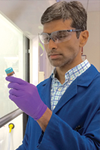 Omar Khan PhD
Omar Khan PhD
Massachusetts Institute of Technology
Title: Implantable Elastic Multielectrode Array for Muscle Conditioning and Epimysial Recording During Peripheral Nerve Repair
Abstract: To create a continuous interface that can both stimulate denervated muscle and monitor regeneration, we have fabricated implantable stretchable multielectrode arrays (sMEAs) consisting of layered Peano curve-patterned titanium/gold electrodes between two layers of polyimide. In this talk, the biocompatibility, surface conformability, electrode impendence, capability of in vivo stimulation, and recording potential of these devices will be discussed.
 Catherine K Kuo PhD
Catherine K Kuo PhD
Associate Professor, Department of Biomedical Engineering, Department of Orthopaedics, Center for Musculoskeletal Research, University of Rochester
Title: Embryonically Inspired Microenvironments for Tissue Regeneration
Abstract: Musculoskeletal tissues such as tendon play critical roles in skeletal movement and stability, yet when injured are incapable of healing with normal functional properties. Our research aims to inform tendon tissue engineering and regenerative medicine strategies by recapitulating aspects of embryonic tissue development and scarless healing. We are using materials science approaches to characterize the structure-property relationships of embryonic tendons, and implementing these findings as design parameters to engineer scaffolds for tendon tissue engineering. Our hypothesis is that 3-dimensional scaffolds that present embryonic tissue cues will instruct adult stem cells to regenerate normal tendon in a manner similar to embryonic cells, rather than form abnormal scar tissue.
 Liisa Kuhn PhD
Liisa Kuhn PhD
University of Connecticut, Health Center
Title: Turn To The Left, Then Turn To The Right: Nanostructured Drug Delivery Systems For Guiding Multiple Steps Of Tissue Regeneration
Abstract: Tissue regeneration involves a cascade of cellular events including infection control, progenitor cell recruitment, proliferation and differentiation. This talk will provide an overview of delivery systems that aim to sequentially deliver multiple factors in order to trigger a recapitulation of the multiple steps of tissue regeneration. The focus will be on layer-by-layer deposition of polyelectrolyte multilayer coatings that include a barrier layer to enable sequential delivery of multiple growth factors for bone regeneration.
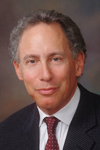 Robert S. Langer PhD
Robert S. Langer PhD
David H. Koch Institute Professor, Massachusetts Institute of Technology, Keynote for the special session on Biomaterials
Title: Biomaterials and biotechnology: From the discovery of the first angiogenesis inhibitors to the development of controlled drug delivery systems and the foundation of tissue engineering
Abstract: Advanced drug delivery systems are having an enormous impact on human health. We start by discussing our early research on developing the first controlled release systems for macromolecules and the isolation of angiogenesis inhibitors and how these led to numerous new therapies. This early research then led to new drug delivery technologies including nanoparticles and nanotechnology that are now being studied for use treating cancer, other illnesses and in vaccine delivery. We then discuss ways of developing novel microchips for drug delivery. Approaches for synthesizing new biomaterials, such as biodegradable polyanhydrides, are then examined, and examples where such materials are used in brain cancer and other diseases are discussed. Finally, by combining mammalian cells, including stem cells, with synthetic polymers, new approaches for engineering tissues are being developed that may someday help in various diseases. Examples in the areas of cartilage, skin, blood vessels and spinal cord repair are discussed.
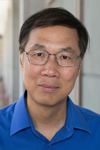 Kam W Leong PhD
Kam W Leong PhD
Samuel Y Sheng Professor, Department of Biomedical Engineering & Department of Systems Biology, Columbia University
Title: Bioengineering Strategies to Advance Biomanufacturing of Cell and Tissue Therapeutics
Abstract: Advances in stem cell biology have led to exciting development in drug screening, in vitro disease modeling, and cell-based therapy. Biomanufacturing will be a critical barrier to realize the full potential of these advances. This presentation will discuss biomaterials-assisted strategies to generate cell and micro-tissue products via combinations of direct cell reprogramming, genome editing, microfluidics, and 3D bioprinting. Emphasis will be placed on approaches that have the potential to be scalable.
 Prabhas V. Moghe PhD
Prabhas V. Moghe PhD
Distinguished Professor of Biomedical Engineering, Rutgers University
Title: Nanobiomaterials for Brain Therapeutics
Abstract: Two major research initiatives in the Moghe laboratory are related to developing new approaches for treating diseases of the brain. The first project is on the use of 3-D biomaterials for dual use of stem cell reprogramming to human neurons and transplantation to the brain (Nature Communications, 2016). The goal is to enable the transplantation of dense neuronal networks to the brain with functional sub-type specificity, for example, dopaminergic neurons to address dopamine deficiency in Parkinsons’ Disease. In the second project, we have identified a new mechanism of action for the clearance and aggregation of the protein, alpha-synuclein, and have advanced a new class of nanotherapeutics for the disruption of alpha-synuclein deposits in the brain microglia, which can ameliorate neurotoxicity underlying neurodegenerative diseases.
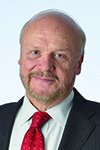 Christopher J. Molloy PhD RPh
Christopher J. Molloy PhD RPh
Senior Vice President, Office of Research and Economic Development, Rutgers, The State University of New Jersey
Opening Speaker
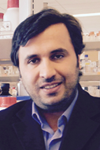 Ibrahim Ozbolat PhD
Ibrahim Ozbolat PhD
Associate Professor, College of Engineering, Penn State University
Title: Bioprinting of Tissues and Organs: From Perfusable Tissues to In Situ Printing
Abstract: Bioprinting is an emerging field that is making a revolutionary impact on the medical sciences. It offers great precision for spatial placement of cells, proteins, genes, drugs and biologically active particles to better guide tissue generation and formation. This emerging biotechnology appears to be promising for advancing tissue engineering toward functional tissue and organ fabrication for transplantation, drug testing, research investigations, and cancer or disease modeling, and has recently attracted growing interest worldwide among researchers and the general public. This talk presents currently ongoing bioprinting research projects at the Penn State University including bioprinting of pancreatic organs for type-1 diabetes, vascular tissue printing, in-situ bone printing, cartilage tissue printing, composite tissue printing for maxillofacial regeneration and bioprinting of brand new types of organs that do not exist in nature.
 Becky Robinson PhD
Becky Robinson PhD
Team Leader & Biomedical Engineer
Pharmacology/Toxicology Branch, Division of Clinical Evaluation and Pharmacology/Toxicology
Office of Cellular, Tissue, and Gene Therapy, Center for Biologics Evaluation and Research U.S. Food and Drug Administration
Title: The Not-So-Odd Couple--Regenerative Medicine and Regulatory Science
Abstract: Cell-scaffold-based regenerative medicine (RM) products offer promising innovative therapeutic strategies for the treatment of a broad range of clinical conditions. Due to their innovative and complex nature, RM products require modification, or in some cases customization for specific patients, throughout the course of their clinical development. Thus, one major challenge is iterative modification to these products and understanding the testing required to implement these modifications. In the Office of Cellular, Tissue, and Gene Therapies (OCTGT) in the Center for Biologics Evaluation and Research (CBER) at the Food and Drug Administration (FDA), recommendations on the preclinical testing programs for investigational RM products are science-based and due to their complexity, case-by-case. When making modifications to these product types, the need for additional preclinical testing is based on a number of factors, including data obtained from regulatory science research. Regulatory science is the science of developing new tools, standards, and approaches to assess the safety, efficacy, quality, and performance of all FDA-regulated products. OCTGT conducts regulatory science research evaluating methods that are applicable to specific manufacturing steps for various cell types that may be a component in a RM product. This research includes providing tools needed to evaluate potential cell sources, techniques for growing/culturing cells, and identifying markers that can predict how the cells will behave in vivo. The combination of science-based preclinical testing recommendations and manufacturing tools developed through regulatory science research are available to facilitate earlier and broader patient access to beneficial RM products.
 Carl G. Simon Jr. PhD
Carl G. Simon Jr. PhD
Biologist-Biosystems & Biomaterials Division, National Institute of Standards and Technology
Title: Measurement Assurance Strategies for Tissue Engineering Research
Abstract: The regenerative medicine industry has identified the inability to reliably characterize cells as possibly its greatest challenge and has called for standards and reference materials to provide assurance for measurements of cell properties. A survey of big pharma by the Alliance for Regenerative Medicine found that “product consistency and lack of standards is possibly the single greatest challenge facing the field” for regenerative medicine [1]. Likewise, a survey by the Regenerative Medicine Foundation found that the “lack of reference materials to benchmark measurements and validation criteria for critical assays” is the biggest roadblock for the field [2]. A regenerative medicine roadmap also identified “cell attribute measurements” as a primary need to enable reproducible manufacturing of high-quality cells [3]. A plan for “reference material cells” has also been proposed, in order to “establish methods of comparability amongst ‘cell’ preparations” [4]. Many challenges in characterization of cell therapy products may be addressed with systematic or formal approaches for assessing sources of uncertainty and improving comparability of key measurements [5]. These measurement assurance approaches have been developed in analytical chemistry [6] and industrial manufacturing [7], and their application to cell measurement will help to establish qualified assays for cell characterization in order to streamline regulatory approval, improve consistency in cell manufacturing and enable more efficient development of cell therapy products. The application of measurement assurance strategies to improve data comparability and to enable confident decision making will be discussed.
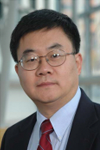 Wei Sun PhD
Wei Sun PhD
Albert Soffa Chair Professor, Department of Mechanical Engineering, Drexel University
Title: From 3DP to Bio-3DP-Challenges and Opportunities
Abstract: 3D Bio-Printing uses cells, biologics and/or biomaterials as building block to fabricate personalized 3D structures or functional in vitro biological models for regenerative medicine, disease study and drug discovery. This presentation will report recent advances on 3D Bioprinting. An overview of 3D Printing to Bio-3D Printing will be given according to its technological development and application stages. Engineering printing process will be reviewed. Examples of applying 3D Printing techniques to develop tissue engineering model, drug testing model and cancer tumor model will be given, along with discussions on challenges and opportunities in the field of Bio-3D Printing.